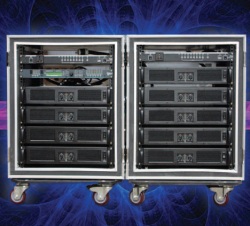
It has to amplify this voltage while sourcing the current being demanded by the load. As I showed in part 1, this gets tougher as the load impedance drops.
For a constant voltage interface (any modern power amplifier), current is a responder. It is the “result” of the drive voltage and load impedance.
Since the load impedance is fixed (unless your loudspeaker overheats), the current (and the resultant power) can only be changed by adjusting the drive voltage to the amplifier. For this reason, I always do my initial assessment of an amplifier based on its maximum sine wave output voltage.
Next I consider the minimum load impedance for which the amplifier can sustain this voltage. The maximum output voltage can be determined from the 8-ohm power rating with the power equation, solved for voltage.
This is easy to verify with an oscilloscope and a (big) dummy load and it is normal to find excellent correlation with the amplifier’s published specifications.

I looked at several of the largest available amplifiers and assessed their voltage output. I won’t compare them here, but the broad conclusion is that an increasing number of them have approximate maximum sine wave voltages in the 130-volt RMS range, which is a peak voltage (multiply by 1.414) close to 200 volts.
The term “200 volt rails” is gaining popularity among the amplifier crowd. I’ll assume that such a voltage is possible in this article. I will verify it in Part 3.
A sine wave of 140 volts RMS will produce these wattages into a resistor from an ideal amplifier (one that can source the required current):
2,500 watts at 8 ohms
5,000 watts at 4 ohms
10,000 watts at 2 ohms*
* theoretical value only!
You can forget about the 10 kW into 2 ohm sine wave rating for lots of reasons, not the least of which is that you can’t draw that from a typical electrical circuit and the chances are slim that you have a true 2-ohm resistive load. 2,500 watts is within 0.2 dB of the maximum power from the electrical outlet.
That’s “dead on” in amplifier world. Note that all of these rated powers exceed the 2,400 watts that is available from the electrical outlet, especially if the amplifier has multiple channels. At these wattages, the utility power may be the limiting factor with regard to what amplifier can do.
To assess the music/speech output voltage, I’ll take the rail voltage and convert to dB, and subtract the crest factor of program material. I’ll be generous and assume a crest factor of 10 dB, which is typical of slightly clipped pink noise. I’ll then convert the level back to voltage.


As you can see, the power drops dramatically when you substitute real-world program material for the sine wave. Now, keep in mind that sometimes real-world program material IS a sine wave. A synthesizer can produce very low crest factor signals that can trip circuit breakers and burn-up a subwoofer connected to the amplifier.
The vast majority of loudspeakers in the marketplace have rated impedances of 4 ohms or higher. The average impedance is higher yet, which is what the amplifier sees if you are playing broadband program material (speech or music). So, to say that we can draw 1 kW from an amplifier is being generous.
It would not be unusual to be able to drive our 2,400-watt amplifier to clipping into a modern line array box using a pink noise signal. Does that mean that the box is “handling” 2,400 watts? No. The high crest factor of the pink noise and the higher real-world average impedance of the loudspeaker means that the power flow is far less than 2,400 watts. It is handling the full voltage swing of the amplifier, but not its full output power.
The high crest factor signal and real-world loudspeaker impedance can allow me to access the full voltage swing of a theoretical amplifier rated at 5 kW/channel into 4 ohms.
Bottom line? The amplifier will run out of voltage swing before it runs out of power.
Crest Factor & Duty Cycle
If the power from a source cannot be sustained over time, it may be interrupted periodically to avoid damage to the source or the production of excessive heat in the load. Examples include pumping the brakes on your car when descending a steep hill, or breaking a long weld into shorter segments.
